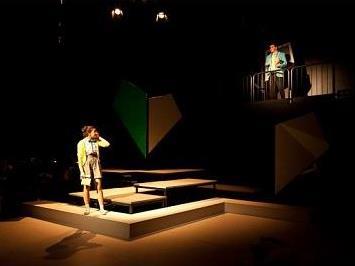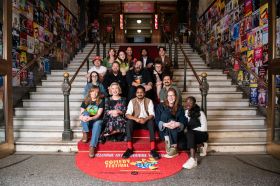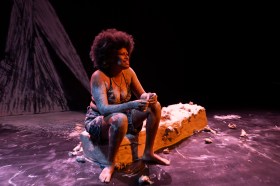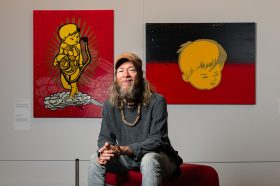Love Letters at St Martin’s, Photo: Pia Johnson
Recently, we were struck by an image from the student protests in response to the 13 May Budget announcement. The photo shows 14 year old Tallulah, a high school student, who sits resolutely in protest on the tram tracks of Exhibition St. A number of adults form a ring around her, two deep, arms linked, protecting her right to protest. This image, perfectly illustrates our practice born of our maxim, children are cultural agents. We celebrate that children have strong, valid, informed and well-formed opinions and youth arts organisations link arms to allow the voices of children to be heard.
Youth arts is in the middle of a seismic shift. Our audiences are changing, so our art is changing. Youth arts practitioners operate in a paradigm where performance is created by the greatest divergent thinkers of our time: children. We regularly make work that is fervently risky, innovative and diverse.
Old perceptions of amateur performances hastily presented to patient, forgiving families are making way for new expectations of captivating cultural product created by children in collaboration with professional practitioners for adult audiences.
Youth theatre is redefining itself as other sectors have done before. Today, disability arts is redefined in the mind of many contemporary art makers and punters. A friend of ours, Ahmarnya Price said “if you are born with a disability you are born subversive”. We believe the presence of children on the nation’s mainstages is equally disruptive, thrilling and honest. This is not new, there are best practice examples all around the world, Ontroerend Goed and the Victoria Campo youth projects in Belgium, Mammalian Diving Reflex in Canada and the extraordinary work on Chiara Guidi in Italy to name just a few. Each of these companies and artists have toured work to Australia. But why should we be a net importer of performance by children. There is a local appetite for work by children, and audiences are ready for work by Australian children. Two local works are particularly noteworthy, a Belvoir and ATYP production of Medea directed by Anne Louise Sarks (four Helpmann Awards) and MTC Neon/Fraught Outfit/St Martins presentation On the Bodily Education of Young Girls directed by Adena Jacobs (three Green Room Nominations). The accolades alone emphasise the shift.
It comes as no surprise that Australia has a history of being at the vanguard of youth theatre. Within 10 years of the first formal youth theatre being established in Britain, stand alone youth theatre organisations, including one on the current St Martins site, quickly sprung up. Since the 1960s the discipline has grown to become a highly skilled professional practice. Youth theatre in Australia has always seeded the dynamic independent and mainstage theatre industry. It is a platform where young people and artists can explore, experiment and take risks making the sector integral to the vitality of the cultural ecosystem. Very few theatre makers who grew up in the cities of our east coast can’t point to a pivotal involvement with one of the countries thirteen federally funded youth theatre organisations at some stage in their childhood or teenage years. This has enormous value for the future of our sector. But it is not youth theatre’s only value. We are firm in the belief that children don’t just inherit our culture, they inhabit it and the work and practice across the nation’s youth arts sector reflects this. Of course, youth theatre, like all performance spans diversity of practices. Each strive to make bold and innovative work that is relevant in their own context and for their own young people. The criteria for that intangible notion of ‘excellence’ needs to find a way to encompass this diversity. Over the past couple of years, organisations have been actively sharing relfection on the common threads that make good practice.
In 2010, St Martins commissioned Gallus Arts to look around the world at evolving youth arts practices. The report; Ambush to Vanguard, Evaluating Excellence in Youth Arts found that the best youth arts practice is risky, innovative and diverse art, recognised for excellence in both process and outcome.
What does this look like for St Martins?
Risky means placing children are the centre of artistic decision making. Diverse means that every process is vigilant and inclusive of multiple perspectives. Innovative means invigorating theatre forms so our work can demonstrate the inherent strengths of children.
Excellent means that the marriage of process and framework results in work that captivates, provokes and challenges our adult audience.
How does this happen? It requires work that is:
Interventionist – like Soundtracks, a new performance intervention where children live describe performances in State Theatres using audio description technology.
Large scale – like On the Bodily Education of Young Girls and our repertoire of new, exciting projects for mainstage and festival contexts.
Provocative – where children lead civic conversations – like the upcoming panel discussions On Death and On Masculinity: A Blush of Boys at the Wheeler Centre.
Participatory – like our friends at Mammalian Diving Reflex and their famous Haircuts by Children and our newest work in development: Fitter, Faster, Better. – a one-on-one micro performance personal training experience.
The goal now for St Martins is simply to create outstanding theatre. We believe children’s inherent cultural agency makes the theatre they create a particularly powerful and potent form for an adult audience. We are vigilant about the integrity of our process and relish the challenges encountered by our collaborating artists. And now, we are opening our doors and calling for all artists, open to the possibility and challenge of creating work with children to train with our team and see if they have what it takes to link arms with us.
An information session on arts practice with children is scheduled for Wednesday 17 September 2014, 6-8pm.
To book email info@stmartinsyouth.com.au





